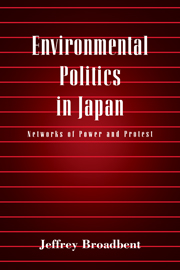Book contents
- Frontmatter
- Contents
- List of figures and tables
- Preface
- 1 Growth versus the environment in Japan
- 2 Visions and realities of growth
- 3 Protest and policy change
- 4 Movement startups
- 5 Protest against Landfill No. 8
- 6 Under the machine
- 7 The Governor gives in
- 8 Contested consensus
- 9 Pyrrhic victories
- 10 Power, protest, and political change
- Appendix 1 Meso-networks and macro-structures
- Appendix 2 Oita prefecture and Japan national growth and environmental key events: 1955–1980
- Appendix 3 Pollution legislation at prefectural and national levels, 1964–1985
- References
- Index
10 - Power, protest, and political change
Published online by Cambridge University Press: 12 January 2010
- Frontmatter
- Contents
- List of figures and tables
- Preface
- 1 Growth versus the environment in Japan
- 2 Visions and realities of growth
- 3 Protest and policy change
- 4 Movement startups
- 5 Protest against Landfill No. 8
- 6 Under the machine
- 7 The Governor gives in
- 8 Contested consensus
- 9 Pyrrhic victories
- 10 Power, protest, and political change
- Appendix 1 Meso-networks and macro-structures
- Appendix 2 Oita prefecture and Japan national growth and environmental key events: 1955–1980
- Appendix 3 Pollution legislation at prefectural and national levels, 1964–1985
- References
- Index
Summary
What may we conclude now, having perused the foregoing stories and information, about the how and why of Japan's GE dilemma? What does that, in turn, tell us about the principles by which Japanese society operates? About the principles of politics and social movements more generally? About the GE dilemma in general? Have any lessons emerged that might prove helpful to the wider world, as it struggles to come to grips with intensifying environmental deterioration?
We can boil questions about the GE dilemma down to one main dimension of possibilities. Did the political conflicts around industrial growth directly reflect its realist, material effect - intensity of sulfur dioxide pollution in the air, prevalence of sickness, gain of profit and loss of livelihood, rearrangement of living patterns? Or were these conflicts also more or less influenced by interpretive, sociocultural factors - the manner in which our social roles and rules, and our collective, but subjective, values, beliefs and identities, interpret both natural and social events and channel our responses to them? This dimension of questioning stretches from realist through socially-constructed to culturally constructed sorts of explanations.
The preceding chapters have presented us with instances of all three sorts of behavior. We will want to disentangle the interactive skein of causation they brought about within the details of the case. But first, we should look once again at the bigger picture - Japan in comparison to other ACID societies - as we did in Chapter 1. This time, though, we can tailor the comparison more closely to these questions about the GE dilemma.
- Type
- Chapter
- Information
- Environmental Politics in JapanNetworks of Power and Protest, pp. 331 - 368Publisher: Cambridge University PressPrint publication year: 1998

